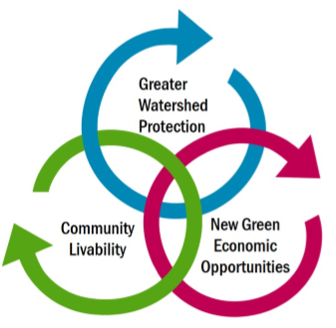Green Streets, Green Jobs, Green Towns (G3) Integrated Planning

On this page:
- Integrated Planning
- Why Integrated Planning?
- Integrated Planning Resources
- Integrated Planning Tools
Integrated Planning
Small to mid-sized communities are looking for ways to boost their local economies in conjunction with protecting their water resources. Integrating the G3 Approach into the design-build of stormwater best management practices (BMPs) empowers communities to gain better access to restoration resources that support local improvements for their contributions in overall watershed protection.
The graphic on the right shows the overall goals of a community's "Green Vision" and the integrated relationship they have. Aligning the planning and implementation of infrastructureThe physical structures and facilities that support the functioning of a community, including roads, sewers, water lines and power supplies. in a community will result in greater watershed protection, new economic opportunities and an increase in community livability.
EPA has embraced integrated planning approaches to municipal wastewater and stormwater management. Integrated planning assists communities in achieving the human health and water quality objectives of the Clean Water Act (CWA) by identifying efficiencies in implementing requirements that arise from distinct wastewater and stormwater programs, including how best to make capital investments.
Integrated planning can also facilitate the use of sustainable and comprehensive solutions, including green infrastructure, that protect human health, improve water quality, manage stormwater as a resource, and support other economic benefits and quality of life attributes that enhance the vitality of communities. In February, 2012, EPA released “Planning for Sustainability: A Handbook for Water and Wastewater Utilities”. The Handbook describes a number of steps communities can take to build sustainability considerations into their existing planning processes and make the best infrastructure choices that protect water quality and ensure the long-term sustainability of infrastructure assets.
The integrated planning approach does not remove obligations to comply with the CWA, nor does it lower existing regulatory or permitting standards, but rather recognizes the flexibility in the CWA for the appropriate sequencing and scheduling of work.
Through integrated planning, a community can achieve:
- eco-efficiences and
- cost-effectiveness
Why Integrated Planning?
There can be little doubt that the opposite of integration - fragmentation - remains a substantial obstacle to improving local planning efforts. Fragmented interests, jurisdictions, ownership, planning responsibility, budget allocations, social and ecological systems, information and knowledge all contribute to the challenge of planning on an integrated and sustainable basis. Addressing this fragmentation, in governance and conceptual thinking, is an essential part of making the ever more necessary fundamental changes for sustainable community development.
Integrated planning is a holistic approach to community development and redevelopment. It is a collaborative effort between local government and community members to evaluate the socio-economic needs of the community and how to balance those needs with the natural systems on which the community depends. An integrated approach is planning focused and inherently strategic. Integrated planning requires the strategic consideration of connectivity (temporal and spatial) among landscape, planning and development actions, and social wellbeing. Such an approach considers the implications of human induced change for landscape integrity and environmental and social sustainability.
(Source: Integrated Community Sustainability Planning Tool )
Integrated Planning Resources
- Building Local Partnerships: A Guide for Watershed Partnerships (PDF)(12 pp, 615 K) - Conservation Technology Information Center's (CTIC) Watershed Guides series provides useful information for all stages of planning. This guide describes challenges and benefits to partnerships, development of partners, obstacles, technical advisor committees and selection, how to conduct effective meetings and team building exercise. These partnerships can help support a holistic approach to planning.
- Putting Together a Watershed Management Plan: A Guide for Watershed Partnerships (PDF)(16 pp, 619 K) - Conservation Technology Information Center's (CTIC) watershed management plan guide is another part of their Watershed Guides. This particular guide explains how to put together a plan. It covers gathering and analyzing information, setting objectives, selecting management alternatives, developing strategies, measuring and evaluating progress.
- EPA's Integrated Planning for Municipal Stormwater and Wastewater - EPA, states, and municipalities often focus on each Clean Water Act (CWA) requirement individually. This may not be the best way to address municipalities from addressing its most serious water quality issues first. An integrated planning approach offers a voluntary opportunity for a municipality to propose to meet multiple CWA requirements by identifying efficiencies from separate wastewater and stormwater programs and sequencing investments so that the highest priority projects come first. This approach can also lead to more sustainable and comprehensive solutions, such as green infrastructure, that improve water quality and provide multiple benefits that enhance community vitality.
Integrated Planning Tools
- Watershed Resources Registry The Watershed Resources Registry (WRR) is an interactive GIS-based screening tool, a product of the Green Highways Partnership and Maryland State Highway Administration’s Route 301 Project, created to improve resource planning and mitigation decision-making using a watershed approach, by integrating regulatory and non-regulatory programs. Historically, program management decisions have been constrained by the “stovepipe” or programmatic nature of the agencies’ legislation. This narrow approach, while useful for specific resource protection, impedes broad-based collaborative planning and application of environmental programs. The element that makes the WRR unlike many other mapping and targeting tools is the level of agency collaboration and program integration.
